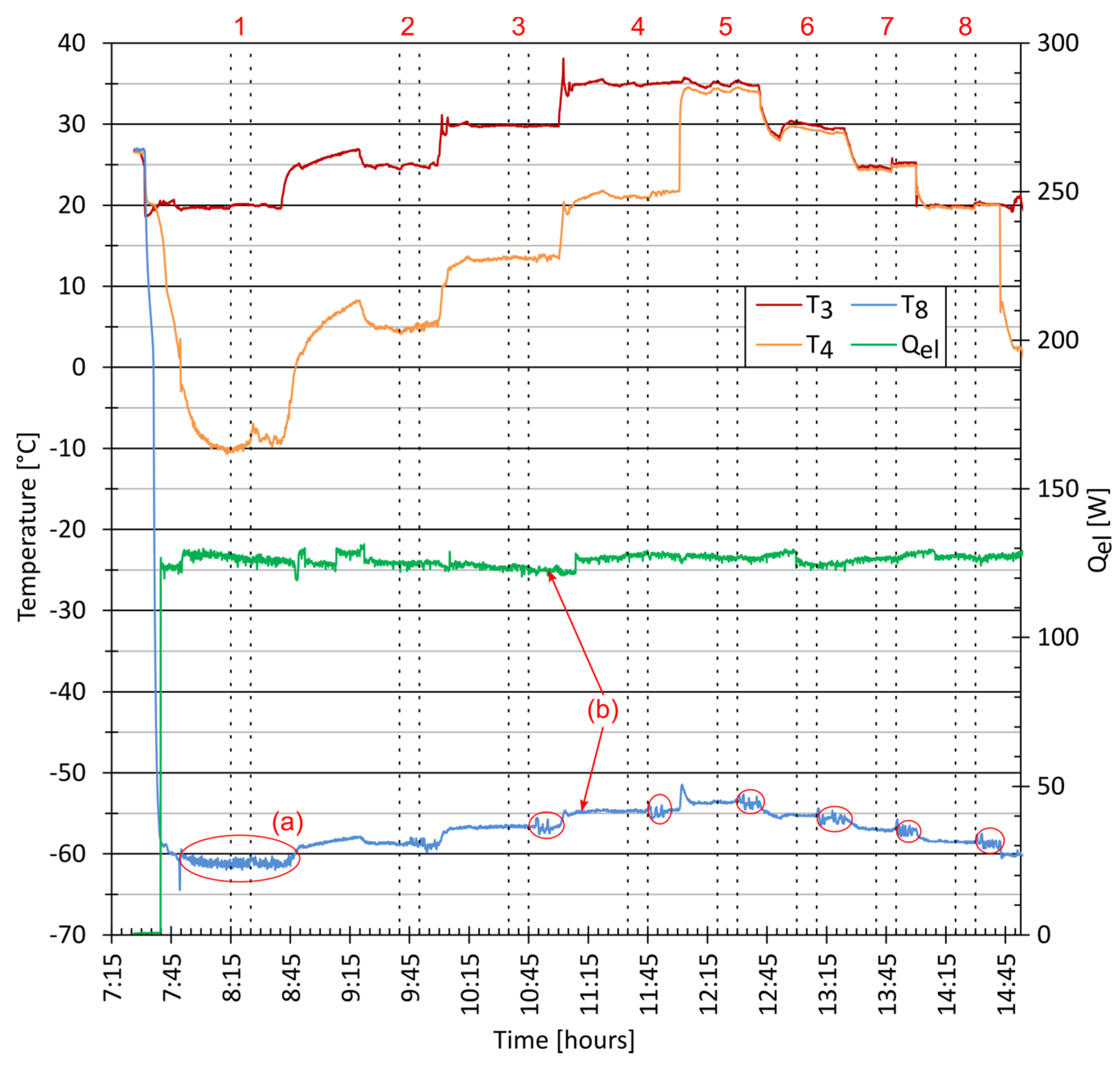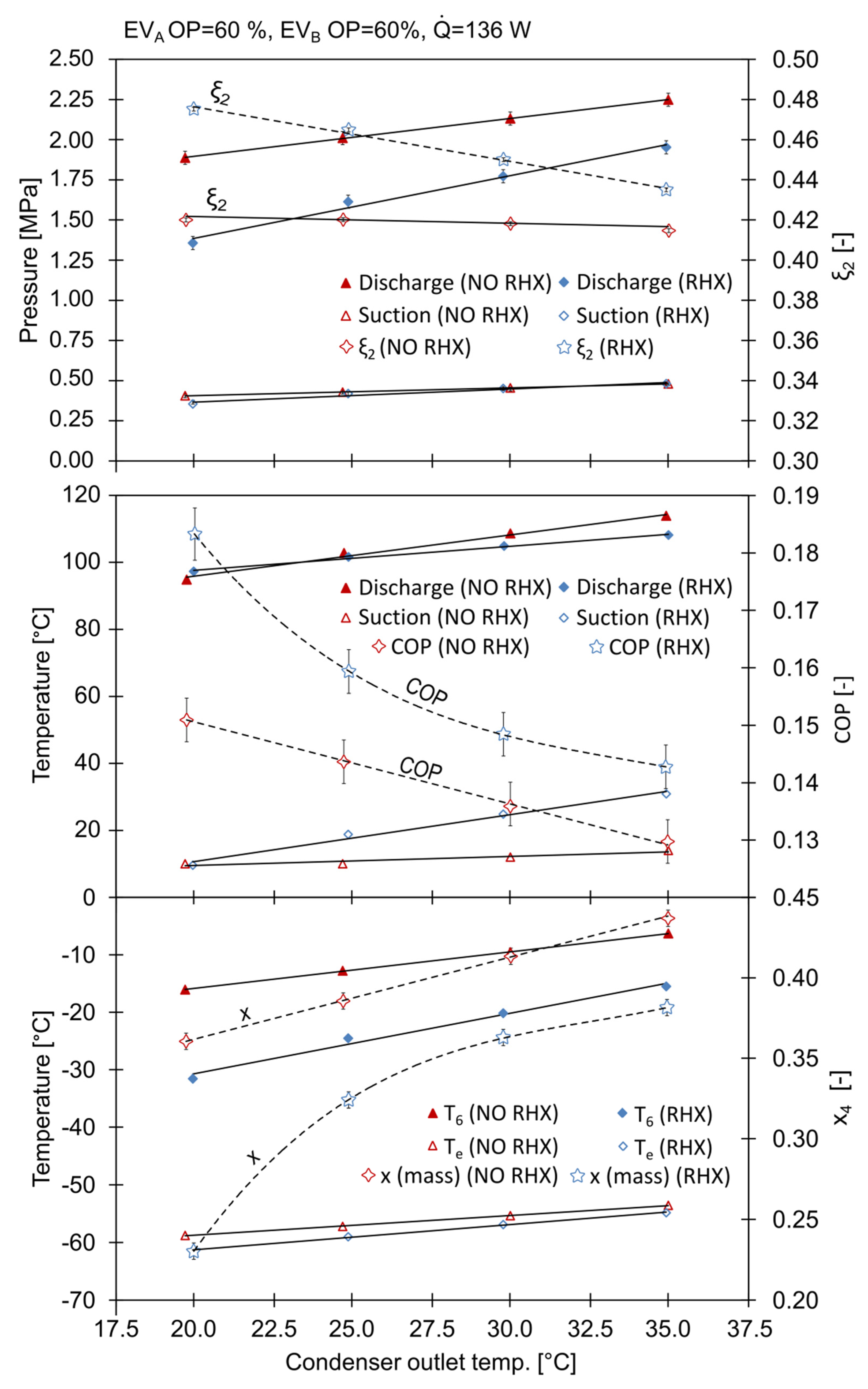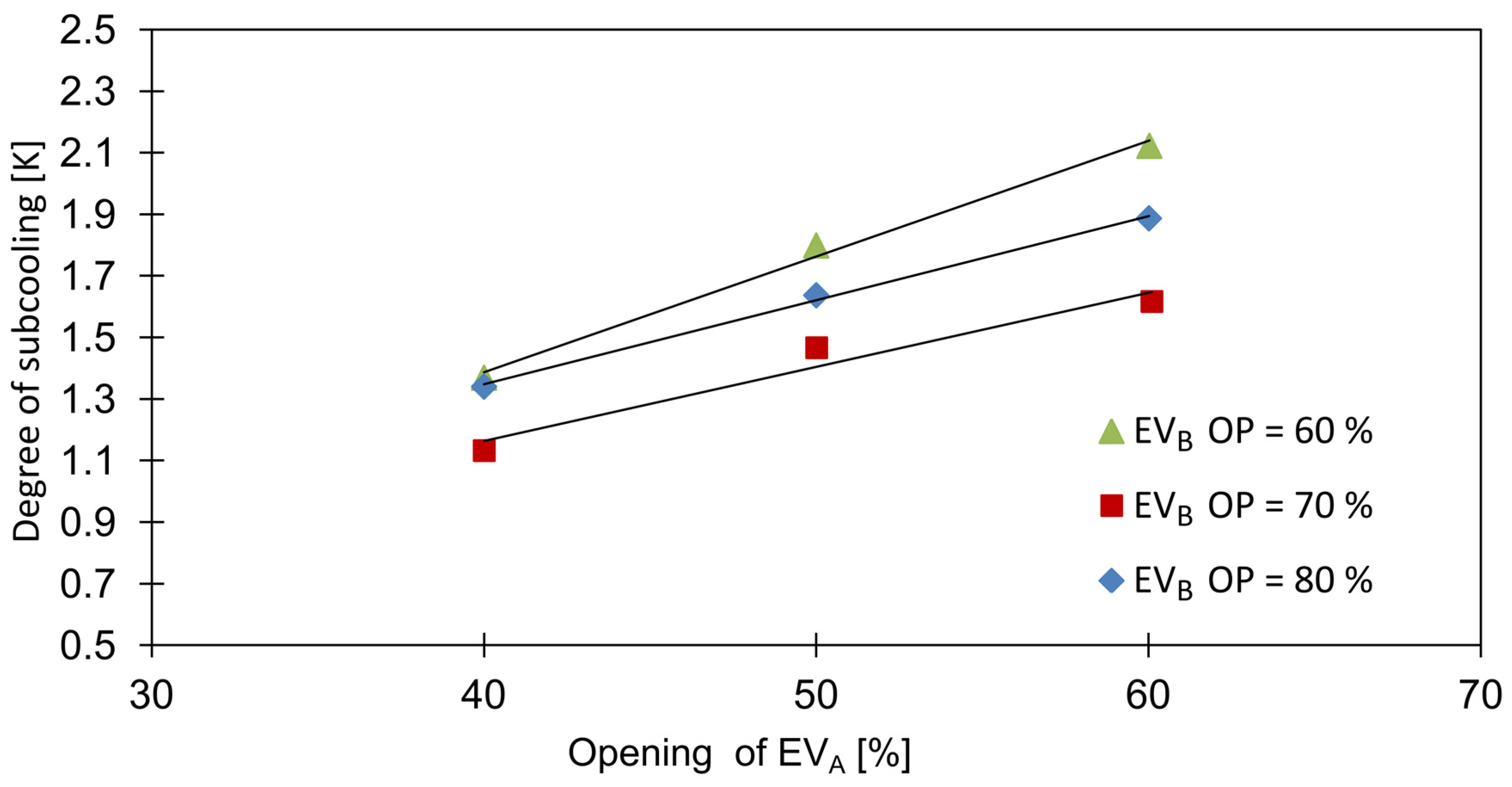Experimental Investigation of the Effect of a Recuperative Heat Exchanger and Throttles Opening on a CO2/Isobutane Autocascade Refrigeration System
Abstract
1. Introduction
2. Experimental Setup and Procedure
3. Results and Discussion
3.1. RHX and Condensing Temperature
3.2. Expansion Valves Openings
4. Conclusions
Funding
Conflicts of Interest
Nomenclature
| Symbols | |
| enthalpy (J kg−1) | |
| heat transfer rate (W) | |
| pressure (bar) | |
| compressor input power (W) | |
| temperature (°C) | |
| temperature difference (K) | |
| vapor quality (mass basis) (-) | |
| Greek Symbols | |
| mass fraction (-) | |
| Subscripts | |
| high boiling–point component | |
| low boiling–point component | |
| subcooling | |
| superheating | |
| saturated liquid | |
| saturated vapor | |
| Abbreviations | |
| cascade heat exchanger | |
| outer diameter | |
| recuperative heat exchanger | |
References
- European Commission. Regulation (EU) No 517/2014 of the European Parliament and of the Council of 16 April 2014 on Fluorinated Greenhouse Gases and Repealing Regulation (EC) No 842/2006 Text with EEA Relevance; European Commission: Brussels, Belgium, 2014. [Google Scholar]
- Ciconkov, R. Refrigerants: There is still no vision for sustainable solutions. Int. J. Refrig. 2018, 86, 441–448. [Google Scholar] [CrossRef]
- Lorentzen, G. The use of natural refrigerants: A complete solution to the CFC/HCFC predicament. Int. J. Refrig. 1995, 18, 190–197. [Google Scholar] [CrossRef]
- Karampour, M.; Sawalha, S. State-of-the-art integrated CO2 refrigeration system for supermarkets: A comparative analysis. Int. J. Refrig. 2018, 86, 239–257. [Google Scholar] [CrossRef]
- Catalán-Gil, J.; Nebot-Andrés, L.; Sánchez, D.; Llopis, R.; Cabello, R.; Calleja-Anta, D. Improvements in CO2 booster architectures with different economizer arrangements. Energies 2020, 13, 1271. [Google Scholar] [CrossRef]
- Haida, M.P.; Fingas, R.; Szwajnoch, W.; Smolka, J.; Palacz, M.; Bodys, J.; Nowak, A.J. An object-oriented R744 two-phase ejector reduced-order model for dynamic simulations. Energies 2019, 12, 1282. [Google Scholar] [CrossRef]
- Nebot-Andrés, L.; Calleja-Anta, D.; Sánchez, D.; Cabello, R.; Llopis, R. Thermodynamic analysis of a CO2 refrigeration cycle with integrated mechanical subcooling. Energies 2019, 13, 4. [Google Scholar] [CrossRef]
- Stoecker, W.F. Industrial Refrigeration Handbook; McGraw-Hill: New York, NY, USA, 1998. [Google Scholar]
- Aprea, C.; Maiorino, A. Autocascade refrigeration system: Experimental results in achieving ultra low temperature. Int. J. Energy Res. 2009, 33, 565–575. [Google Scholar] [CrossRef]
- Gong, M.; Wu, J.; Cheng, Q.; Sun, Z.; Liu, J.; Hu, Q. Development of a −186 °C cryogenic preservation chamber based on a dual mixed-gases Joule–Thomson refrigeration cycle. Appl. Therm. Eng. 2012, 36, 188–192. [Google Scholar] [CrossRef]
- Gong, M.; Wu, J.; Luo, E.; Qi, Y.; Zhou, Y. Study of the single-stage mixed-gases refrigeration cycle for cooling temperature-distributed heat loads. Int. J. Therm. Sci. 2004, 43, 31–41. [Google Scholar] [CrossRef]
- Yan, G.; Hu, H.; Yu, J. Performance evaluation on an internal auto-cascade refrigeration cycle with mixture refrigerant R290/R600a. Appl. Therm. Eng. 2015, 75, 994–1000. [Google Scholar] [CrossRef]
- Chen, Q.; Zhou, L.; Yan, G.; Yu, J. Theoretical investigation on the performance of a modified refrigeration cycle with R170/R290 for freezers application. Int. J. Refrig. 2019, 104, 282–290. [Google Scholar] [CrossRef]
- Du, K.; Zhang, S.; Xu, W.; Niu, X. A study on the cycle characteristics of an auto-cascade refrigeration system. Exp. Therm. Fluid Sci. 2009, 33, 240–245. [Google Scholar] [CrossRef]
- Xu, X.; Liu, J.; Cao, L. Mixed refrigerant composition shift due to throttle valves opening in auto cascade refrigeration system. Chin. J. Chem. Eng. 2015, 23, 199–204. [Google Scholar] [CrossRef]
- Chen, Q.; Yu, J.; Yan, G. Performance analysis of a modified zeotropic mixture (R290/R600) refrigeration cycle with internal subcooler for freezer applications. Appl. Therm. Eng. 2016, 108, 172–180. [Google Scholar] [CrossRef]
- Bai, T.; Yan, G.; Yu, J. Experimental investigation of an ejector-enhanced auto-cascade refrigeration system. Appl. Therm. Eng. 2018, 129, 792–801. [Google Scholar] [CrossRef]
- Podbielniak, W.J. Art of Refrigeration. U.S. Patent 2041725, 26 May 1936. [Google Scholar]
- Kim, S.; Kim, M.S. Experiment and simulation on the performance of an autocascade refrigeration system using carbon dioxide as a refrigerant. Int. J. Refrig. 2002, 25, 1093–1101. [Google Scholar] [CrossRef]
- Yu, B.; Yang, J.; Wang, D.; Shi, J.; Chen, J. Modeling and theoretical analysis of a CO2-propane autocascade heat pump for electrical vehicle heating. Int. J. Refrig. 2018, 95, 146–155. [Google Scholar] [CrossRef]
- Zhang, L.; Xu, S.; Du, P.; Liu, H. Experimental and theoretical investigation on the performance of CO2/propane auto-cascade refrigerator with a fractionation heat exchanger. Appl. Therm. Eng. 2015, 87, 669–677. [Google Scholar] [CrossRef]
- Bai, T.; Yan, G.; Yu, J. Experimental research on the pull-down performance of an ejector enhanced auto-cascade refrigeration system for low-temperature freezer. Energy 2018, 157, 647–657. [Google Scholar] [CrossRef]
- Rozhentsev, A. Refrigerating machine operating characteristics under various mixed refrigerant mass charges. Int. J. Refrig. 2008, 31, 1145–1155. [Google Scholar] [CrossRef]
- Rui, S.; Zhang, H.; Zhang, B.; Wen, D. Experimental investigation of the performance of a single-stage auto-cascade refrigerator. Heat Mass Transf. 2015, 52, 11–20. [Google Scholar] [CrossRef]
- Fuderer, A. Compression Process for Refrigeration. U.S. Patent 3203194, 31 August 1965. [Google Scholar]
- Sobieraj, M.; Rosiński, M. High phase-separation efficiency auto-cascade system working with a blend of carbon dioxide for low-temperature isothermal refrigeration. Appl. Therm. Eng. 2019, 161. [Google Scholar] [CrossRef]
- Di Nicola, G.; Polonara, F.; Stryjek, R.; Arteconi, A. Performance of cascade cycles working with blends of CO2 + natural refrigerants. Int. J. Refrig. 2011, 34, 1436–1445. [Google Scholar] [CrossRef]
- Sobieraj, M.; Rosiński, M. Experimental study of the heat transfer in R744/R600a mixtures below the R744 triple point temperature. Int. J. Refrig. 2019, 103, 243–252. [Google Scholar] [CrossRef]
- Kondo, S.; Takizawa, S.; Takahashi, A.; Tokuhashi, K.; Sekiya, A. Flammability limits of isobutane and its mixtures with various gases. J. Hazard. Mater. 2007, 148, 640–647. [Google Scholar] [CrossRef]
- Kondo, S.; Takizawa, K.; Takahashi, A.; Tokuhashi, K. Extended Le Chatelier’s formula and nitrogen dilution effect on the flammability limits. Fire Saf. J. 2006, 41, 406–417. [Google Scholar] [CrossRef]
- Tian, H.; Wu, M.; Shu, G.-Q.; Liu, Y.; Wang, X. Experimental and theoretical study of flammability limits of hydrocarbon–CO2 mixture. Int. J. Hydrogen Energy 2017, 42, 29597–29605. [Google Scholar] [CrossRef]









| Parameter | Uncertainty |
|---|---|
| Temperature | ±0.1 K |
| Pressure (high side) | ±0.41 bar |
| Pressure (low side) | ±0.12 bar |
| Power | ±2 W |
| Mass flow rate | ±0.1% |
| Evaporator heat load | ±1.0% |
| Coefficient of performance | ±2.5% |
| Vapour quality | ±3% |
| Composition | ±0.2% |
| Series | RHX | RHX | RHX | CHX | CHX | CHX | CHX | |
|---|---|---|---|---|---|---|---|---|
| (°C) | (K) | (K) | (K) | (K) | (K) | (K) | (K) | |
| 1 | 20.3 | 10.4 | 12.6 | 9.1 | 14.3 | 10.7 | 3.3 | 2.2 |
| 2 | 24.9 | 6.1 | 18.5 | 13.0 | 19.7 | 14.0 | 4.6 | 1.7 |
| 3 | 29.8 | 4.9 | 22.7 | 15.9 | 23.6 | 15.5 | 5.9 | 1.3 |
| 4 | 34.9 | 4.0 | 26.2 | 19.1 | 27.1 | 16.4 | 7.2 | 0.7 |
| 5 | 19.7 | 0.0 | 0.0 | 0.0 | 29.6 | 17.8 | 10.0 | 0.0 |
| 6 | 24.7 | 0.0 | 0.0 | 0.0 | 31.7 | 18.1 | 11.8 | −0.5 |
| 7 | 30.0 | 0.0 | 0.0 | 0.0 | 33.6 | 18.6 | 13.4 | −1.0 |
| 8 | 35.0 | 0.0 | 0.0 | 0.0 | 31.0 | 19.1 | 12.4 | −1.6 |
| Mass Flow (g s−1) | ||||
|---|---|---|---|---|
| EV | A | |||
| 40 | 50 | 60 | ||
| B | 80 | 4.55 | 4.62 | 4.78 |
| 70 | 4.56 | 4.65 | 4.75 | |
| 60 | 4.45 | 4.84 | 4.94 | |
| Mass Flow(g s−1) | ||||
| EV | A | |||
| 40 | 50 | 60 | ||
| B | 80 | 2.42 | 2.31 | 2.13 |
| 70 | 2.18 | 2.07 | 1.95 | |
| 60 | 1.83 | 1.49 | 1.33 | |
| Mass Flow(g s−1) | ||||
| EV | A | |||
| 40 | 50 | 60 | ||
| B | 80 | 6.97 | 6.93 | 6.92 |
| 70 | 6.74 | 6.72 | 6.70 | |
| 60 | 6.28 | 6.34 | 6.26 | |
© 2020 by the author. Licensee MDPI, Basel, Switzerland. This article is an open access article distributed under the terms and conditions of the Creative Commons Attribution (CC BY) license (http://creativecommons.org/licenses/by/4.0/).
Share and Cite
Sobieraj, M. Experimental Investigation of the Effect of a Recuperative Heat Exchanger and Throttles Opening on a CO2/Isobutane Autocascade Refrigeration System. Energies 2020, 13, 5285. https://doi.org/10.3390/en13205285
Sobieraj M. Experimental Investigation of the Effect of a Recuperative Heat Exchanger and Throttles Opening on a CO2/Isobutane Autocascade Refrigeration System. Energies. 2020; 13(20):5285. https://doi.org/10.3390/en13205285
Chicago/Turabian StyleSobieraj, Michał. 2020. "Experimental Investigation of the Effect of a Recuperative Heat Exchanger and Throttles Opening on a CO2/Isobutane Autocascade Refrigeration System" Energies 13, no. 20: 5285. https://doi.org/10.3390/en13205285
APA StyleSobieraj, M. (2020). Experimental Investigation of the Effect of a Recuperative Heat Exchanger and Throttles Opening on a CO2/Isobutane Autocascade Refrigeration System. Energies, 13(20), 5285. https://doi.org/10.3390/en13205285





